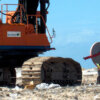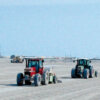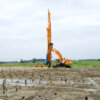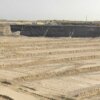“Facts About Soil Improvement” describes how to accelerate the consolidation of reclaimed land increasing its strength to bear the weight of construction.
Potential reclamation sites are shallow coastal zones or marshy lowlands and the soil in these areas often consists of thick layers of soft clay or silts. Reclamation work increases the load on these soft layers, causing widespread settling. Waiting for the natural settlement of this land is time-consuming and thus costly and could put a project in jeopardy if it cannot be accomplished in a designated period of time.
To accelerate the settlement process, dredging contractors have developed specialised ways of consolidating soft soils and subsoils. In addition, newly reclaimed soil is often in a loose state and may not meet the demands of the planned infrastructure and therefore needs to be improved. Both consolidation techniques for cohesive soils (clay, silt) and compaction techniques used to solidify granular soils are frequently used.
Consolidation has become an essential part of soil improvement. Several techniques have been developed which include:
- preloading or surcharging the area that is subject to consolidation with a temporary load of sand,
- using Prefabricated Vertical Drains (PVDs), sand drains and a system known variously as BeauDrain, Intensive Forced Compaction (IFCO) or Press-To-Drain (PTD), and
- vacuum consolidation.
These are all methods in which soil improvement takes place over a longer period of time, though shorter than natural settlement.
Compaction is done by methods such as:
- smooth rollers,
- High Energy Impact Compaction (HEIC),
- Dynamic Compaction (DC) – also known as heavy tamping, or
- Rapid Impact Compactors (RIC) and vibroflotation.
In addition, some soil improvement methods can provide a cost-effective means of reducing soil contamination. Dewatering contaminated soil has a twofold effect. Some of the improved soil can be reused for construction projects, eliminating the need to mine new pit sand. The remaining unusable sediment is reduced in quantity, decreasing the amount of storage space needed, which is always a costly, environmentally sensitive issue. As well, when additives such as cement are used during soil improvement they both increase the bearing capacity of soils for construction works and also immobilise contaminated marine sediments.
“Facts About Soil Improvement” answers essential questions such as:
- What is soil improvement?
- Why is soil improvement important?
- What is the difference between consolidation and compaction?
- What is dynamic compaction?
- What is rapid impact compaction?
- What is high energy impact compaction?
- What is explosive compaction?
- What is vibroflotation?
- How does soil improvement reduce environmental impacts?
- How does soil improvement help in earthquake-prone regions?
- Why is soil liquefaction dangerous?
- What are vertical or wick drains?
- What is vacuum consolidation?
- What are the beaudrain, ifco and ptd systems?
- Can soil replacement be a means of soil improvement?
- What are admixtures and in-situ soil mixing?
- What is the sand drain system?
- How are geotextiles used for soil improvement?
- What are other advantages of soil improvement?
- Is soil improvement always necessary?
- Is one soil improvement system preferable over another?










